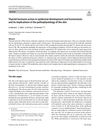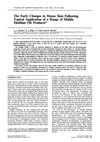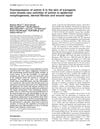Search
forLearn
4 / 4 resultslearn Thymosin Beta 4
learn Low Level Laser Therapy
laser therapy for anti-inflammatory and likely insignificant hair regrowth effects
learn Osteopontin
signaling protein that, when suppressed, may grow hair by reducing inflammation and stem cell loss
Research
5 / 1000+ results
research Thyroid Hormone Action in Epidermal Development and Homeostasis and Its Implications in the Pathophysiology of the Skin
Thyroid hormones are important for skin health and changes in them can affect conditions like hair loss and eczema.

research The Early Changes in Mouse Skin Following Topical Application of a Range of Middle Distillate Oil Products
Different oil products cause varying levels of skin irritation in mice, which could potentially lead to tumors.
research A Folliculocentric Perspective of Dandruff Pathogenesis: Could a Troublesome Condition Be Caused by Changes to a Natural Secretory Mechanism?
Dandruff might be caused by changes in how hair follicles naturally release oils and an immune response to this imbalance.

research Developmental Genetics of Color Pattern Establishment in Cats
Cat color patterns are determined early in development by gene expression and epidermal changes, with the Dickkopf 4 gene playing a crucial role.

research Overexpression of Activin A in the Skin of Transgenic Mice Reveals New Activities in Epidermal Morphogenesis, Dermal Fibrosis, and Wound Repair
Overexpression of activin A in mice skin causes skin thickening, fibrosis, and improved wound healing.
Community Join
5 / 82 results
community Minoxidil Response Bottlenecks: Why Sulfation and Transport Matter (And Where Tretinoin Fits In)
Minoxidil's effectiveness is limited by the need for sulfation and proper transport to hair follicles, with tretinoin potentially enhancing its effects by promoting enzyme activity and keratinocyte differentiation. Tretinoin may improve minoxidil's response by boosting the expression of necessary enzymes and transporters.
community Topical finasteride has affected my hormones
A 21-year-old experienced hormone changes after using self-made topical finasteride for hair loss, including a 20% decrease in DHT, a 47% increase in testosterone, and a 39% increase in estradiol. The user previously used minoxidil and microneedling but is now seeking ways to balance hormones, possibly through supplements or dosage adjustments.
community Is tazarotene potentially better than tretinoin in combination with topical minoxidil?
Tazarotene may be more effective than tretinoin when combined with topical minoxidil for hair loss due to its selective binding to RAR-beta and gamma, though it can cause irritation. Tazarotene's potency can lead to indirect inflammatory reactions despite potentially causing less irritation than tretinoin.
community only microneedling and supplements
The user used microneedling, zinc, vitamin D3, biotin, magnesium, saw palmetto, pumpkin seed oil, and a DHT-blocker shampoo with biotin for hair loss. They are considering adding minoxidil due to stagnation in progress.
community The Real Cause Of Androgenetic Alopecia
Androgenetic alopecia is caused by DHT affecting hair growth. Finasteride and minoxidil are used to manage hair loss by blocking DHT and promoting hair growth.